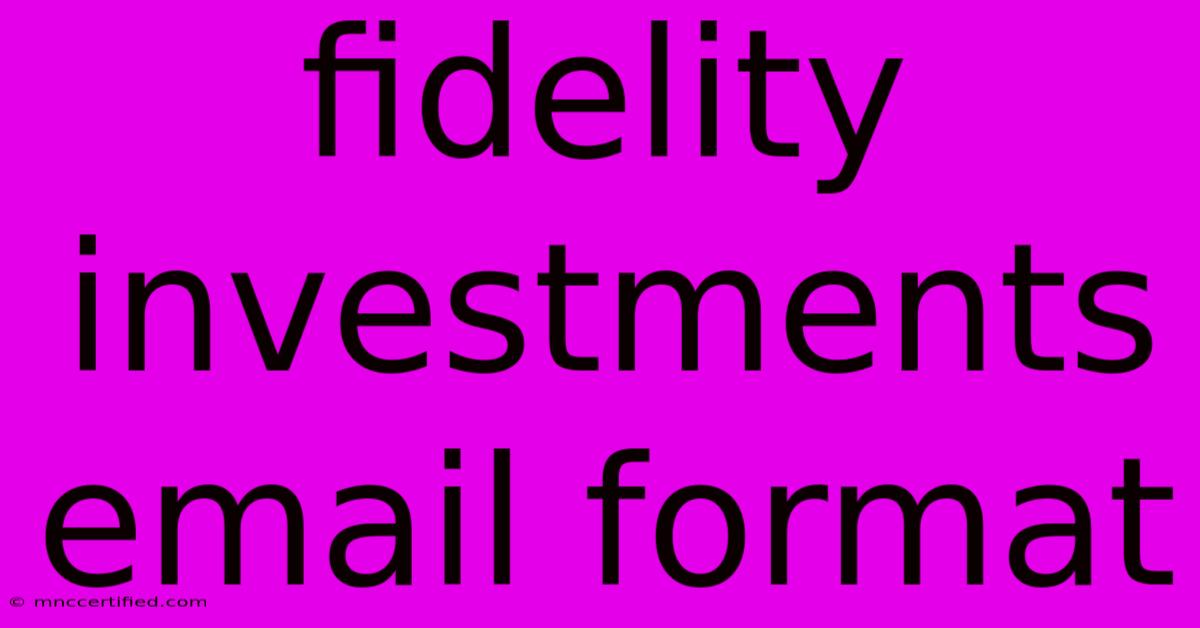Fidelity Investments Email Format

Table of Contents
Decoding Fidelity Investments Email Formats: A Guide to Spotting Legitimate Emails
Fidelity Investments, a renowned financial services company, sends numerous emails to its customers. However, with the rise of phishing scams, it's crucial to know how to identify genuine Fidelity emails from fraudulent ones. This guide will help you understand the common formats of Fidelity Investments emails and how to spot potential red flags.
Identifying Authentic Fidelity Emails: Key Features
Fidelity prioritizes security, and their email formats reflect this. Here's what to look for when checking the authenticity of an email supposedly from Fidelity:
1. Sender Email Address: The Cornerstone of Verification
- Genuine Emails: Legitimate Fidelity emails will typically use addresses ending in @fidelity.com, @fidelity.co.uk (for UK customers), or similar variations depending on your region. Look closely – fraudulent emails often mimic the address closely but include subtle differences, like extra characters or slightly altered domain names.
- Red Flags: Addresses from free email providers (like Gmail, Yahoo, Hotmail) or those with unusual characters or misspellings are major red flags. Be extra cautious with addresses that are slightly off, such as
fidelty.comorfidelityinvestments.net.
2. Email Content: Professionalism and Personalization
- Genuine Emails: Fidelity emails are professional, well-written, and often personalized. They will address you by name and usually refer to your specific account or recent activity. They’ll avoid overly generic greetings or urgent, demanding language. The language used will be consistent with Fidelity's brand voice – formal and factual.
- Red Flags: Poor grammar, spelling errors, generic greetings (e.g., "Dear Customer"), and overly urgent requests for personal information are strong indicators of a phishing attempt. Be wary of emails promising unrealistic returns or threatening account suspension unless you act immediately.
3. Links and Attachments: Proceed with Caution
- Genuine Emails: Legitimate Fidelity emails will contain links that direct you to their official website (fidelity.com or a regional equivalent). Hover your mouse over the link before clicking to check the actual URL in your browser's status bar. Legitimate emails rarely include attachments unless you've specifically requested them.
- Red Flags: Links that look suspicious or redirect to unfamiliar websites should be avoided. Never download attachments from unsolicited emails. Phishing emails often use attachments to install malware on your computer.
4. Security Measures: SSL Certificates and HTTPS
- Genuine Emails: When you click on a link in a legitimate Fidelity email, the website should load with "HTTPS" in the address bar, indicating a secure connection. Look for a padlock icon in the address bar as well. This shows the website uses SSL encryption to protect your information.
- Red Flags: Websites that load without "HTTPS" are not secure and could be fraudulent.
5. Contacting Fidelity Directly: When in Doubt, Verify
- Genuine Emails: If you're ever unsure about the authenticity of an email, contact Fidelity directly using the phone number or contact information listed on their official website. Never use the contact information provided within a suspicious email.
- Red Flags: A reluctance from the email sender to verify their identity should raise a major red flag.
Different Types of Fidelity Emails: What to Expect
Fidelity sends various emails, including:
- Account Statements: These emails usually notify you of your account activity and provide a summary of transactions.
- Security Alerts: These emails warn you of potential security threats or suspicious activity on your account.
- Promotional Emails: Fidelity may send emails advertising new products or services. Always check the sender's address to verify authenticity.
- Customer Service Updates: These emails might contain important information about account changes or service disruptions.
Remember: Never share sensitive information like your password, social security number, or bank account details in an email, regardless of who it appears to be from.
Off-Page SEO Considerations: Building Authority
To ensure this article ranks well on Google, consider the following off-page SEO strategies:
- Backlinks: Reach out to relevant financial websites and blogs to potentially get backlinks to this article.
- Social Media Sharing: Share this article on social media platforms to increase visibility and engagement.
- Online Forums: Participate in relevant online forums and discussions related to Fidelity and online security.
By following these guidelines and utilizing both on-page and off-page SEO techniques, you can improve the visibility and trustworthiness of your content on search engines. Remember, protecting your financial information is paramount. Always exercise caution when dealing with emails that claim to be from Fidelity Investments or any financial institution.

Thank you for visiting our website wich cover about Fidelity Investments Email Format. We hope the information provided has been useful to you. Feel free to contact us if you have any questions or need further assistance. See you next time and dont miss to bookmark.
Featured Posts
-
Stump Grinding Business Insurance
Nov 20, 2024
-
Velocity Investments Llc Suing Me
Nov 20, 2024
-
Shelter Insurance Green Forest Ar
Nov 20, 2024
-
Tenants Legal Liability Insurance
Nov 20, 2024
-
Fidelity Investments Vs Tiaa Cref
Nov 20, 2024